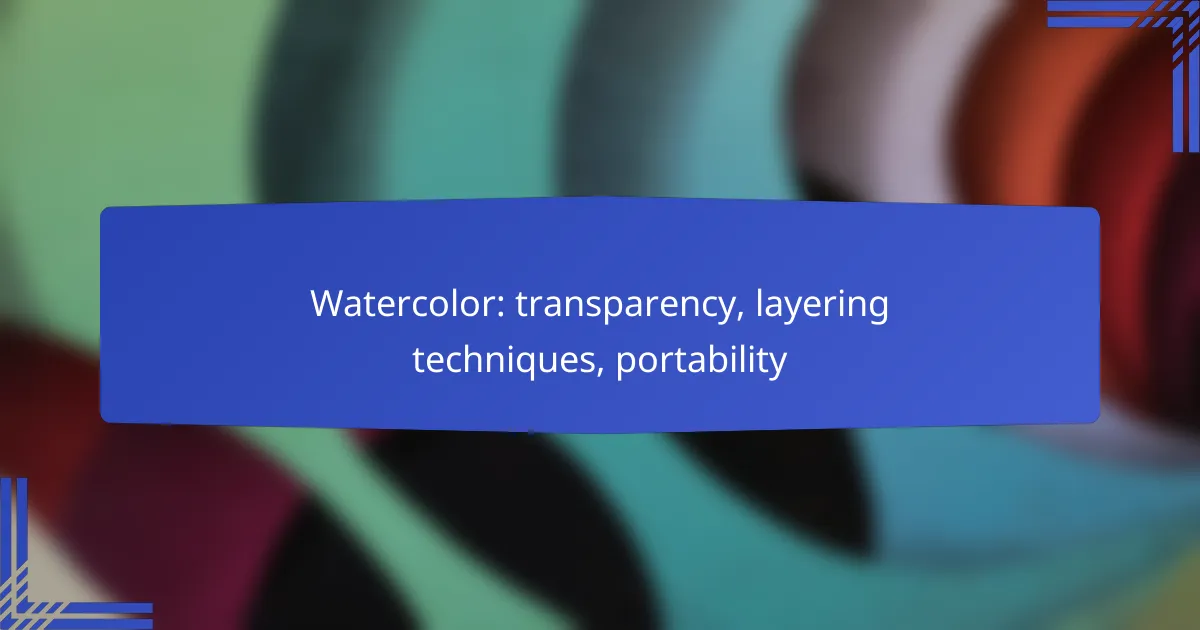Watercolor painting is characterized by its unique transparency, enabling artists to create depth and luminosity through layered colors. By mastering layering techniques, you can build complexity and vibrancy in your artwork. Additionally, selecting portable and lightweight materials ensures that you can easily take your watercolor supplies on the go, allowing for creativity wherever inspiration strikes.
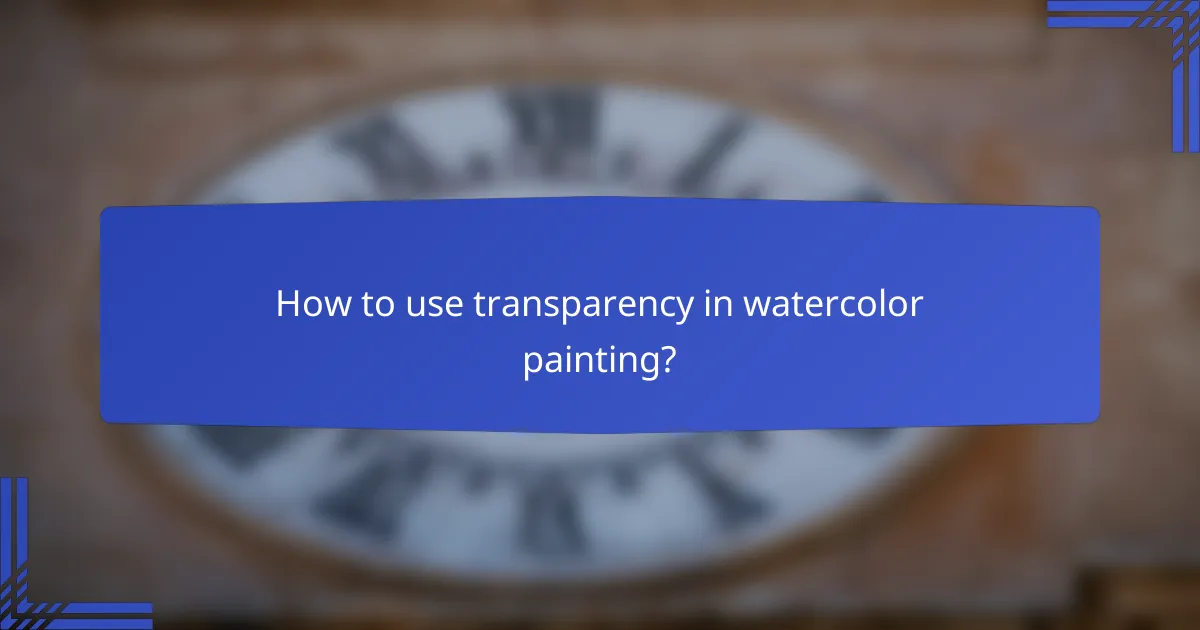
How to use transparency in watercolor painting?
Transparency in watercolor painting allows artists to create depth and luminosity by layering colors. By understanding how to manipulate transparency, you can achieve a wide range of effects and enhance your artwork’s vibrancy.
Understanding transparency levels
Transparency levels in watercolor paints refer to how much light passes through the paint layer. Transparent colors allow underlying layers to show through, while opaque colors block light and obscure layers beneath. Knowing the transparency of your paints helps in planning your layering strategy.
Most watercolor paints are categorized as transparent, semi-transparent, or opaque. Transparent paints are ideal for glazing techniques, while opaque paints can be used for more solid applications. Familiarize yourself with the characteristics of your paint to make informed choices.
Choosing transparent watercolor paints
Selecting the right transparent watercolor paints is crucial for achieving desired effects. Look for paints labeled as “transparent” on their packaging or in product descriptions. Brands often provide swatches that demonstrate transparency levels, which can guide your selection.
Some popular transparent colors include Quinacridone Rose, Phthalo Blue, and Hansa Yellow. These pigments are known for their clarity and ability to create vibrant washes. Experiment with different brands to find those that suit your style and preferences.
Techniques for layering transparent washes
Layering transparent washes involves applying multiple thin layers of paint to build depth and complexity. Start with a light wash and allow it to dry completely before adding another layer. This technique creates a rich interplay of colors and enhances luminosity.
When layering, consider the drying time of your washes. Watercolor dries lighter than it appears when wet, so be mindful of how each layer will affect the overall color. Avoid overworking the paint; instead, let each layer dry before adding more to maintain transparency.
Common pitfalls include using too much water, which can dilute colors excessively, or applying layers too soon, which can muddy the paint. A good practice is to test your layers on scrap paper to see how they interact before applying them to your artwork.
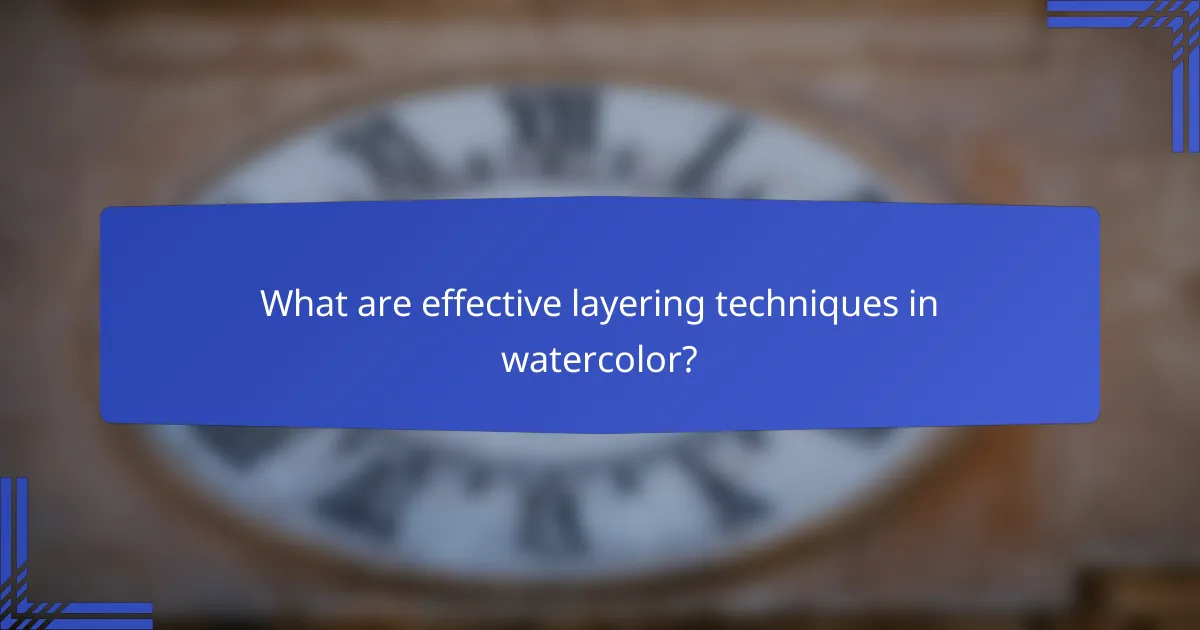
What are effective layering techniques in watercolor?
Effective layering techniques in watercolor involve applying multiple transparent washes to build depth and complexity in your artwork. Mastering these methods allows artists to create vibrant, rich colors and intricate details.
Wet-on-wet layering method
The wet-on-wet layering method involves applying wet paint onto a wet surface, allowing colors to blend and flow into one another. This technique is ideal for creating soft edges and atmospheric effects, such as skies or water.
To use this method, start by wetting your paper with clean water. Then, apply your first wash of color and add additional colors while the surface is still wet. Be mindful of the amount of water you use, as too much can lead to excessive bleeding.
Dry brush layering technique
The dry brush layering technique uses a brush with minimal water to apply paint on a dry surface, resulting in a textured, scratchy effect. This method is perfect for adding fine details or creating the illusion of texture, such as grass or bark.
To achieve this effect, load your brush with paint and remove excess moisture. Lightly drag the brush across the paper, allowing the texture of the paper to show through. This technique works best with thicker paints or when using a small amount of water.
Glazing for depth and richness
Glazing involves applying a transparent wash over a dry layer of paint to enhance color depth and richness. This technique allows for complex color interactions without muddying the underlying layers.
To glaze effectively, ensure that the first layer is completely dry before applying the second wash. Use a transparent paint and apply it in thin layers, gradually building up to your desired intensity. This method is particularly effective for skin tones or landscapes where subtle color variations are needed.
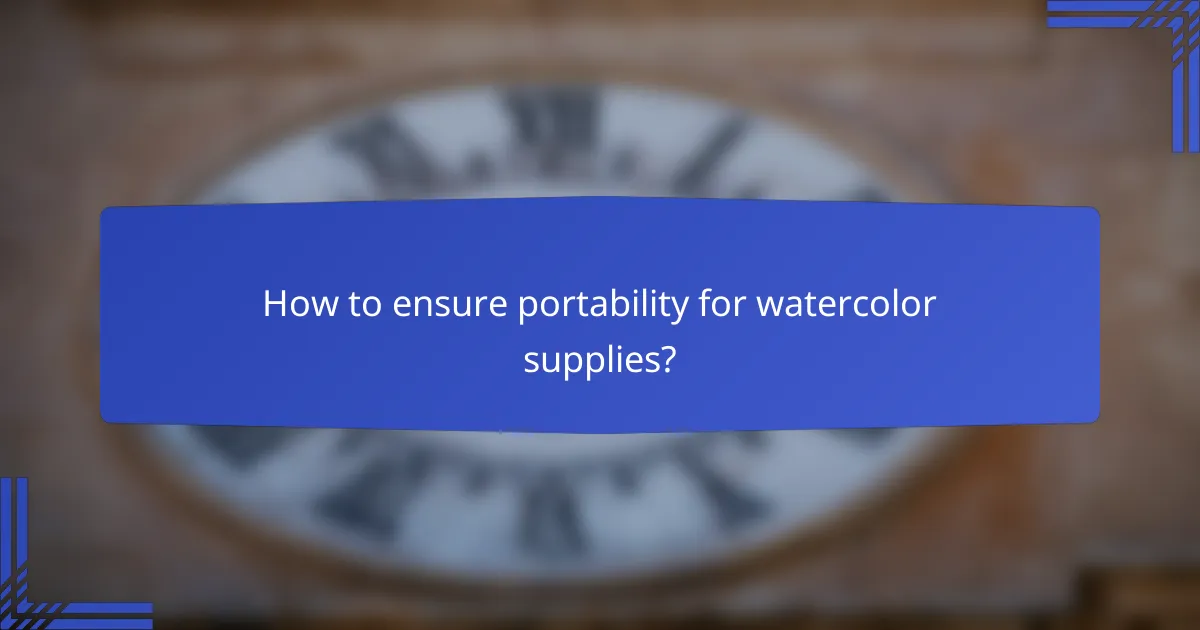
How to ensure portability for watercolor supplies?
To ensure portability for watercolor supplies, choose lightweight, compact materials that fit easily into a bag or backpack. Prioritize multifunctional items and consider the size and weight of each component to maintain convenience while traveling.
Best portable watercolor sets
When selecting portable watercolor sets, look for compact palettes that include a variety of colors yet are small enough to carry. Brands like Winsor & Newton and Daniel Smith offer travel-friendly options that often come with built-in mixing areas and removable pans.
Consider sets with half-pans or tubes, as these can save space and allow for easy refills. A good portable set should weigh less than 1 kg and fit in a small pouch for easy transport.
Choosing travel-friendly paper
Travel-friendly watercolor paper should be lightweight, durable, and able to withstand multiple washes. Look for blocks or pads that are spiral-bound and sized around A5 or A6 for easy packing.
Cold-pressed paper is ideal for layering techniques, while hot-pressed paper is smoother for detailed work. Brands like Arches and Canson provide excellent options that cater to both portability and quality.
Compact brushes for artists on the go
Compact brushes are essential for artists who travel. Look for collapsible or travel brushes that can shrink down to fit in a small case. Brands like Escoda and Princeton offer brushes with retractable handles that maintain quality while being easy to carry.
Consider a set that includes a variety of brush shapes and sizes, such as round, flat, and detail brushes, to cover different techniques. A good rule of thumb is to keep your brush set under 200 grams for optimal portability.
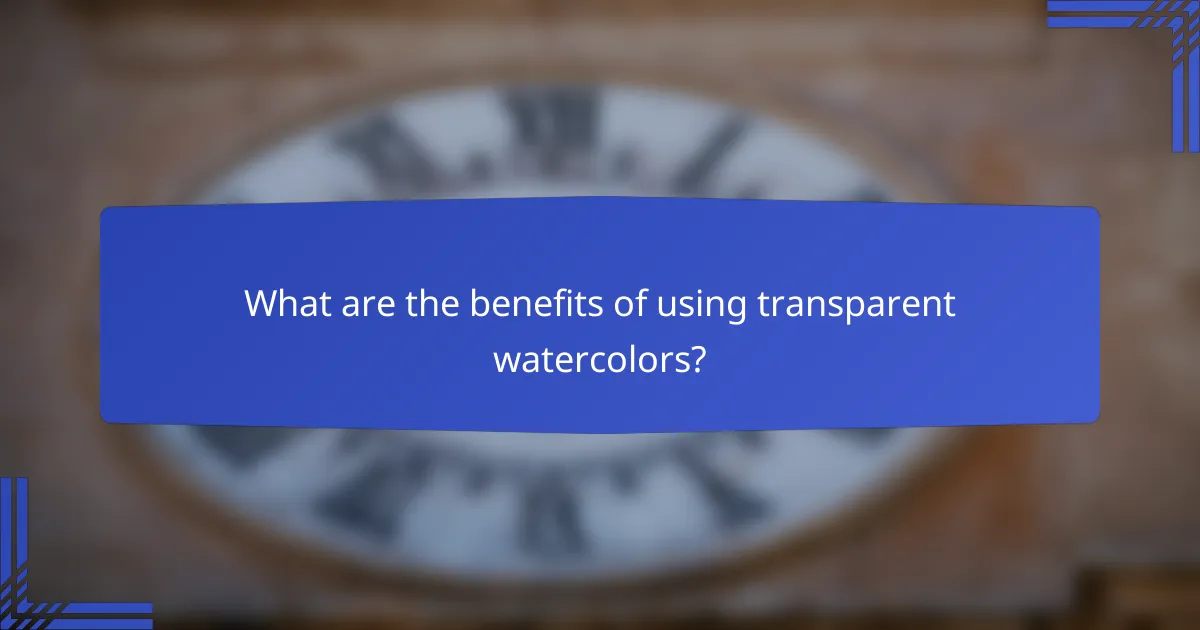
What are the benefits of using transparent watercolors?
Transparent watercolors offer unique advantages, such as the ability to create depth and luminosity in artwork. Their layering capabilities allow artists to build complex color interactions while maintaining a light and airy quality.
Creating luminous effects
Transparent watercolors excel in producing luminous effects due to their light-reflecting properties. When applied in layers, each wash allows light to penetrate and bounce off the paper, creating a glowing appearance. This technique is particularly effective on white or light-colored papers, enhancing the vibrancy of the colors.
To achieve luminous effects, start with a light wash and gradually add layers, allowing each layer to dry before applying the next. This method helps maintain the transparency and ensures that the underlying colors shine through.
Enhancing color vibrancy
Using transparent watercolors can significantly enhance color vibrancy, as they allow for the mixing of hues without losing brightness. When layered, these colors interact in ways that create rich, dynamic tones that are difficult to achieve with opaque paints.
To maximize color vibrancy, consider using a limited palette and focus on complementary colors. This approach not only enhances the overall vibrancy but also creates harmony within the artwork. Avoid muddying colors by ensuring that each layer is fully dry before adding new washes.

What are the prerequisites for watercolor techniques?
To effectively use watercolor techniques, one should understand the principles of transparency and layering, as well as the tools required for portability. Familiarity with these elements will enhance your ability to create vibrant and dynamic artworks.
Essential tools for beginners
Beginners should start with a basic set of watercolor supplies, including watercolor paints, brushes, and paper. A good quality watercolor set can range from affordable student-grade options to more expensive professional brands, depending on your budget.
Invest in a few round and flat brushes in various sizes, as they allow for different techniques and effects. Watercolor paper is crucial; look for 200-400 gsm (grams per square meter) weight to prevent warping when wet.
Basic color theory for watercolor
Understanding color theory is essential for effective watercolor painting. Familiarize yourself with the color wheel, which illustrates primary, secondary, and tertiary colors, helping you mix and create harmonious palettes.
Consider the concepts of warm and cool colors, as they can influence the mood of your artwork. Additionally, learn about complementary colors, which can create contrast and vibrancy when used together in your paintings.
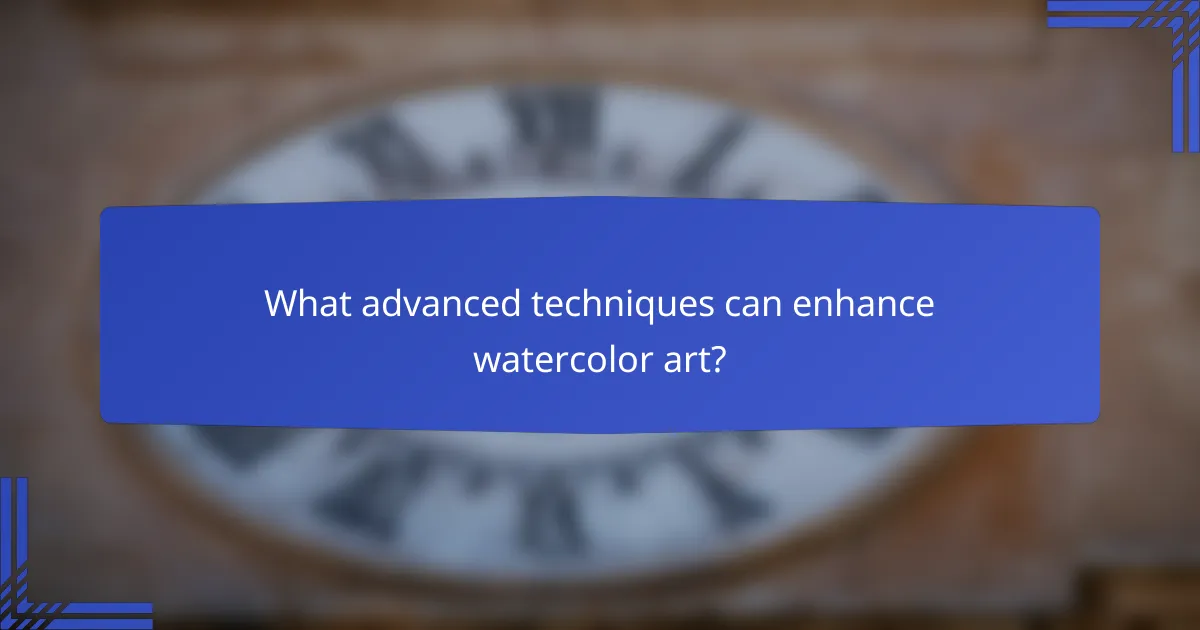
What advanced techniques can enhance watercolor art?
Advanced techniques in watercolor art, such as transparency, layering, and the use of salt for texture, can significantly elevate your work. Mastering these methods allows artists to create depth, vibrancy, and unique effects that enhance the overall composition.
Using salt for texture
Salt can create interesting textures in watercolor paintings by absorbing moisture and pigment as the paint dries. When sprinkled onto wet paint, the salt crystals draw the water away, resulting in unique patterns and effects that can add depth to your artwork.
To effectively use salt, apply it to areas of wet paint and allow it to dry completely before brushing off the excess. Experiment with different types of salt, such as coarse sea salt or table salt, as they produce varying textures. Keep in mind that the size of the salt grains will affect the final look, so try to use a consistent grain size for uniformity.
Be cautious with the amount of salt used; too much can overwhelm the painting and detract from the overall composition. A light sprinkling often yields the best results, allowing the watercolor to shine through while still providing texture.
